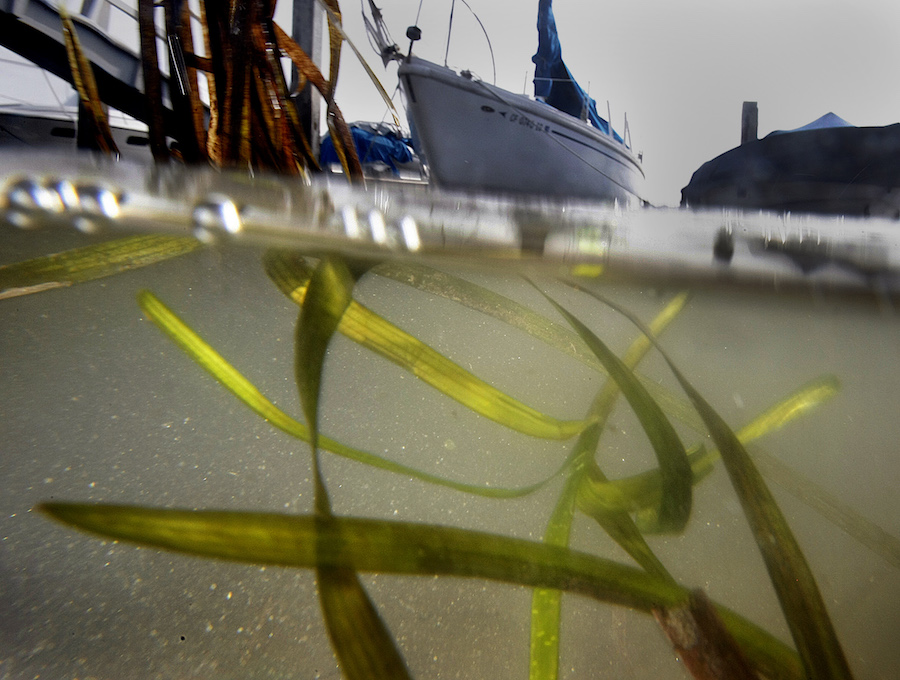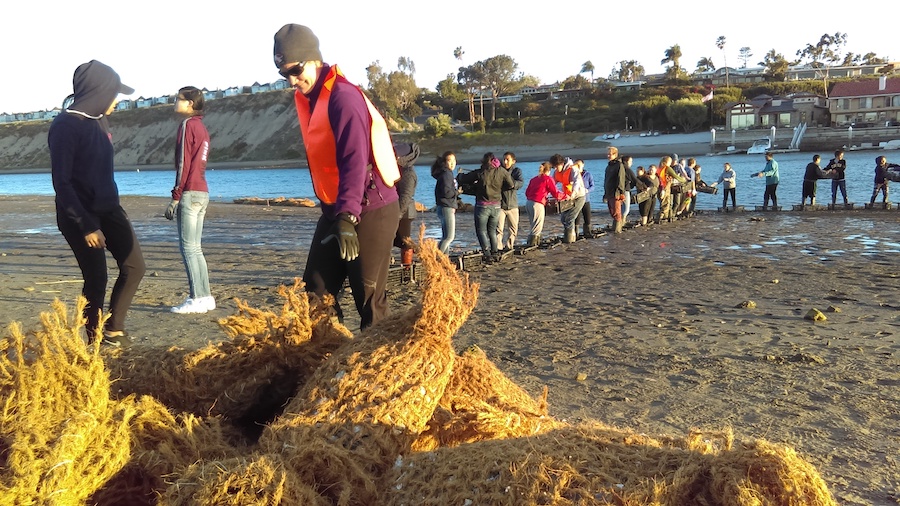On a sunny afternoon in April, Katie Nichols crouched over the edges of a small oyster reef in Newport Bay, California, peering into the mud that had been exposed by the receding tide. Where all I saw was a jumble of interchangeable shell fragments, Nichols quickly spotted what she was looking for.
“There,” she said, pointing to a small, white shell. “That’s what a native looks like.”
Nichols was pointing to an Olympia oyster, the only oyster species native to the Pacific Coast of the United States. Smaller and rounder than non-native Pacific oysters, it was once abundant in the bays and estuaries of the California coast — but during the gold rush in the 1880s, the native species was overharvested, and the population collapsed. The oyster became “functionally extinct” in Southern California, according to Nichols, and today, much of the habitat where it could have settled has been degraded.

Nichols, the marine restoration director of Orange County Coastkeeper, a nonprofit clean water organization in Southern California, is working on a project trying to resurrect the Olympia oyster — at least in Newport Bay — and is trying to understand whether the unassuming bivalve could be a key part of helping coastlines adapt to the impacts of climate change.
As the earth’s temperature warms, coastal populations around the world are wrestling with how to adapt to rising seas. In order to protect coastal development from erosion and encroaching waters, America is shielding its coasts with concrete armor — literally. Coastal armoring refers to the construction of hard structures like seawalls along coasts, and nearly 14 percent of American coastline is already armored. That portion could increase to one-third by 2100 if current rates continue.
This armor could actually be doing more harm than good. According to Molly Melius, program manager at Stanford University’s Environmental and Natural Resources Law and Policy Program, seawalls can reduce beach width, decrease sand replenishment of beaches, and also accelerate erosion at the ends of seawalls. In some cases, seawalls are inadvertently accelerating the problem they were designed to solve. Coastal armor can also degrade ecosystems that might naturally protect the shoreline from erosion. “Previously, before a lot of development, there was a lot of room for shoreline migration,” said Nichols, meaning that coastal ecosystems could migrate along with the coastline. The development of concrete structures like seawalls and other kinds of armor produces an effect called “coastal squeeze,” meaning that these ecosystems are not able to migrate. “You can lose whole coastal habitats” this way, says Melius.
Nichols and her team are setting out to test an alternative path to protecting coastlines — one that involves using the ecosystems that already exist or once existed along the coast, instead of squeezing them out. Nichols oversees Coastkeeper’s living shorelines program, a project in partnership with California State University, Long Beach, and California State University, Fullerton, that restores ecosystem structures like oyster beds and eelgrass meadows, which protect shorelines from waves, erosion, and sea-level rise. Nichols says the goal of living shorelines is to create organic structures to protect coasts, “instead of using boulders and rocks.”
In 2017, Coastkeeper set out to put the idea of living shorelines to the test in Upper Newport Bay. A team of volunteers and restoration workers hauled 40,000 pounds of Pacific oyster shells in biodegradable bags made of coconut husk onto the shore, to create a structure in which the larvae of native oysters could settle. The Olympia oyster population “isn’t larvae limited,” says Nichols, meaning there are more than enough oyster larvae in the water to allow oysters to repopulate under the right conditions. The problem is the lack of suitable habitat for oyster reefs to form. Bringing in oyster shells to create a habitat allows these larvae to take root on the shoreline and form a self-sustaining oyster bed.

It’s now been four years since the restoration work in Newport Bay began, and Nichols took me to see how the shoreline has progressed. Clad in knee-high rain boots and carrying two shallow plastic crates, we approached the shoreline. “You have to take care not to disturb the sediment,” Nichols warned, setting down a plastic crate on the wet sand. Standing in the crates helps distribute weight, so we wouldn’t leave scars in the sediment as we walked across the sand. We set down one crate after the other, cautiously leapfrogging across the shore to approach the exposed reefs. A small section of PVC pipe emerged from the reef like a sentinel, measuring how much sediment the reef traps over time.
Oyster reefs provide a whole host of important environmental benefits — a single oyster can filter as much as 50 gallons of water a day, improving water quality, and the structure of the reef provides homes for other sea critters, including fish, crabs, and other bivalves. Reef structures also work as a natural barrier against storm surges. And most pertinent to those concerned about climate adaptation, they also help prevent the coastline from eroding. As waves and tides hit the shorelines, the structure of the oyster bed absorbs the energy from those waves and traps sediment. “Instead of just having sediment loss, you might get what we call accretion, or some buildup,” explained Nichols. Understanding just how much sediment these oyster beds accumulate is important for making decisions about land use and restoration along coastlines. “If this small, 20-meter bed is really important in slowing down erosion, and we can track that over time, that’s really good for managers and policy folks who are trying to deal with sea-level rise,” said Nichols.
Oyster beds aren’t the only thing that Coastkeeper is working on restoring. Nichols and her team have also planted meadows of eelgrass, another native California coastal species that has been almost eliminated regionally. Christine Whitcraft, a professor of biological sciences at California State University, Long Beach, has been studying eelgrass since her doctorate. “I am more well versed in seagrass than I ever thought I would be,” she quips. According to Whitcraft, up to 90 percent of seagrass meadows in California have been lost — but it’s hard to put an exact number on it, due to lack of good monitoring programs. Much like oyster reefs, eelgrass can provide vital benefits for the broader ecosystem and for people, including by providing habitats and nursery grounds for other species, improving water quality, and stabilizing sediments in their long root systems, further preventing coastal erosion.

In addition to helping mitigate the impacts of rising seas, eelgrass provides another critical climate change function: carbon burial. Eelgrass absorbs carbon through photosynthesis, then stores it in its root structure for millennia — even after the eelgrass dies. Much like permafrost and peat, the sediments beneath eelgrass meadows are wet, cold, and low in oxygen, meaning that the carbon stored there doesn’t decompose and get released into the atmosphere. “High sediment accumulation rates and low degradation rates — that’s the magic formula” for carbon storage, says Whitcraft. For that reason, marine ecosystems that store carbon, like mangroves, salt marshes, and seagrass meadows, are much more efficient at storing carbon than a forest on a square-foot basis.
Even while they dutifully sequester away carbon and stabilize the coastline, eelgrass and oysters are themselves threatened by the impacts of rising temperatures. In addition to the effects of coastal development and water pollution, warming waters and heat waves can also lead to eelgrass and oyster mortality. “Eelgrasses are combating climate change, but at the same time climate change is impacting them in negative ways, so it’s sort of a tug and pull between the two of them,” says Whitcraft. “It’s a very interesting feedback loop.”
As a part of its research, Coastkeeper is testing out the effectiveness of restoring eelgrass and oyster beds both separately and together in test sites along the shore. Nichols says that restoring both eelgrass and oysters simultaneously will create a more complete habitat, from an ecological perspective, and the coastline can reap the benefits of each. But the project is small, for now — the extent to which it can be scaled up is still an open question. Eelgrass and oysters might not work for living shorelines projects everywhere — different regions might have different strategies or species that suit the area best, says Nichols, like marshes, dunes, or kelp. But Coastkeeper is “hoping to translate our work to useful strategies for managers in Southern California” — a proof of concept for what could one day be a larger-scale solution.



